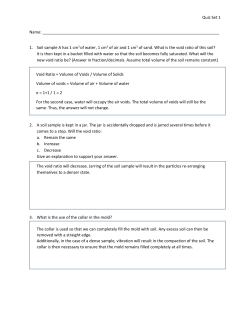
SOIL SAMPLE Soil Samples Should Be Carefully Mixed and Packaged.
Soil Samples Should Be Carefully Mixed and Packaged. • Collect all cores or slices taken for a given sample in a clean bucket and mix thoroughly. • Samples may be dropped off at your county Extension office or mailed directly to: Soil Testing Program 152 Townsend Hall CANR University of Delaware Newark, DE 19716-2170 • Soil sample bags, sample information sheets, and sampling instructions are available at your county Extension office. • Purchasing a sample bag automatically pays for routine analysis. Please pay for special tests in advance at the county Extension office, and include the receipt with your sample. • Fill the soil sample bag to the indicated line with the mixed soil. Forwarding the Sample. • Be sure to name each sample and keep a complete record of what area is represented by each sample. • Fill out the information sheet provided with each sample bag and place in the attached envelope. • Do not use sample bags other than those provided by the laboratory. SOIL SAMPLE HOW TO TAKE A FOR HOME LAWNS AND GARDENS CIRCULAR #19 SOIL TESTING LABORATORY How Often Should Soil Be Tested? • Once adequate fertility levels are established, lawn and ornamental areas need only be sampled every 2 to 3 years. • Vegetable gardens should be sampled every 1 to 2 years. • Where lime is likely to be needed, be sure to sample well in advance of planting. Because lime reacts fairly slowly, it should be mixed with soil several months before planting. Prepared by D.R. Parker, Research Associate, Soil Testing printed 2007 The University of Delaware is committed to assuring equal opportunity to all persons and does not discriminate on the basis of race, color, gender, religion, ancestry, national origin, sexual orientation, veteran status, age, or disability in its educational programs, activities, admissions or employment practices as required by Title IX of the Educational Amendments of 1972, Title VI of the Civil Rights Act of 1964, the Rehabilitation Act of 1973, the Americans with Disabilities Act, and other applicable statutes. Inquiries concerning these statutes and information regarding campus accessibility should be referred to the Affirmative Action Officer, 305 Hullihen Hall, (302) 831-2835 (voice), or (302) 831-4552 (TDD). Department of Plant and Soil Sciences College of Agricultural and Natural Resources University of Delaware Newark, DE 19716-2170 S ose conducted OIL TESTS such as th laware Soil by the University of De ll help you to Testing Laboratory wi more productive soil develop and maintain on about the fertility by providing informati lps you to select the status your soil. This he tilization program so proper liming and fer timal growth of lawn, that you can obtain op tal plants. garden, and ornamen curate as the A soil test is only as ac made. A soil sample sample on which it is und is used to repreweighing about 1/2 po ds of soil in the lawn sent thousands of poun it is extremely imporor garden. Therefore, be properly and caretant that soil samples fully taken. A Good Soil Sample Should Represent the Area. • Take soil from at least 10 locations (X) in the sampled area and mix together in a clean bucket. • For trees and shrubs, take soil from 5 to 6 spots around the base of the plant and mix. Sample to the Proper Depth. • Remove any surface litter such as turf thatch or mulch. • For lawns, sample down to 4-5 inches. For gardens and ornamentals sample down 6-8 inches. • Use a trowel, spade, or sampling tube to collect soil. To use a trowel or spade, vertically cut a slice of soil about 2 inches thick to the correct depth. Do Not Contaminate the Sample. • Use clean sampling tools and containers. Each Soil Sample Should Represent Only One Soil Type or Soil Condition. Areas where past treatment has been different should be sampled separately. In the above example, three samples should be taken_one each from the garden, the lawn, and the shrub planting. If front and back lawns have been treated differently, take a separate sample from each. Identify Problem Areas With Soil Tests. • Areas where plants grow differently and/or the soil appears different should be sampled separately. • NEVER use tools or containers that have been used for fertilizer or lime. A small amount of fertilizer or limestone residue on tools or hands can cause serious contamination of the sample.
© Copyright 2025





















